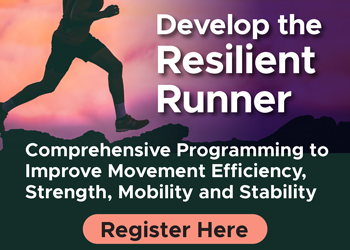Course Outline
Prehab instead of Rehab! Reducing Running Injuries by being Proactive
Stuart Wilson, PT |
With the right combination of mobility, stability, and other important "movement habits," you'll gain effective skills that you can implement in the clinic right away. Apply the strategies to common injuries such as runner's knee, ITB syndrome, Achille's tendinopathy, plantar fasciitis, and more.
Strength Training for Runners — Design Programs Your Patients Will Actually Do!
Tony Mikla, DPT, CSCS, XPS |
Create straightforward, efficient, and practical exercises to help your patients develop well-rounded strength with these interventions that are easy, adaptable, and help reduce injuries.
Foundations of Linear Speed
Tony Mikla, DPT, CSCS, XPS |
Linear speed drives all the movements and behaviors we coach every day: gait, balance, lunge, step up, stairs, and of course, running. When you break down the mechanics, needs for mobility vs. stability, and patterns of sprinting — you can glean critical insights for all of the patients you treat. You'll establish a map of exercise progressions that go from a basic state of movement through advanced with specific clinical drills you can implement right away. This protocol is guaranteed to provide movement improvement with a long-lasting impact.
Truth, Lies, & Running Analysis: How to be the Running Expert in Your Community
Jon Mulholland, DC, CCSP, CSCS |
- Perform a 'low cost' gait analysis
- How to spot the most common biomechanical errors in runners
- Achilles' tendonitis
- Identify the type of foot strike that is increasing the risk of injury
You'll also "bust" some popular running beliefs. What is the optimal foot strike? What about the "minimalist" running movement? How do I choose the best running sneaker for me?
Foot and Ankle: Quickly Identify and Assess Dysfunction &
Foot and Ankle Dysfunction: Eliminate Foot Pain and Unnecessary Procedures
Courtney Conley, DC, founder of Gait Happens with over 145,000 followers on Instagram |
- In-depth biomechanical analysis of the foot and ankle anatomy that will enhance your clinical decision making
- Differential diagnosis for the most prevalent conditions: plantar fasciitis, Achilles tendonitis, posterior tibial tendonitis, and ankle sprains — and effective treatment protocols tailored to each pathology
- How to improve foot function without using an orthotic or brace
- Long-term effects of chronic ankle instability — and how to address it!
Patella Femoral Pain. Problem Solved
Tony Mikla, DPT, CSCS, XPS |
Gain clarity on how to narrow in on the true limiting factors and align specific interventions in the clinic. No matter how the patient presents, you can get them back to activities and sports pain-free with this consistent approach.
Knee Secrets: Progressions and Assessments from the Table to the Field
Tony Mikla, DPT, CSCS, XPS |
- The full spectrum of knee assessment and intervention for every patient type and ability level
- A concise framework for every aspect of evaluation: tightness, strength, and tolerance
- Unique ways to challenge movement — without additional loading!
- Fill the clinical void that many clinicians overlook — a better appreciation for the importance of training single-leg stance
Running after Pregnancy
Julia Mitchell, PT |
Practical postpartum and external pelvic health strategies that can be used by women at ANY stage postpartum, whether they had a baby 6 weeks ago, 6 months ago, or 6 years ago.
- Determine when to return to running
- Exercise progressions that increase strength, stability, and mobility
- Techniques that aid in quickly mitigating poor running mechanics
Runner's Toolkit: Find the Faults and Fix Them Fast
Milica McDowell, MS, DPT |
Paul Herberger, BS, CPT CF-2 |
Practical tools to identify the root cause of the running faults, tactics for mobility/stability, and low-cost interventions that get results fast, like kinesiology taping. From 5K newbies to ultra-distance runners, their approach will help improve your confidence and skills when working with these athletes.

